XFX GeForceFX 5700 Ultra – Graphics Card Review
XFX GeForceFX 5700 Ultra – Graphics Card
They say that you can't teach an old dog new tricks, and in the case of the GeForceFX 5700 Ultra this definitely rings true.
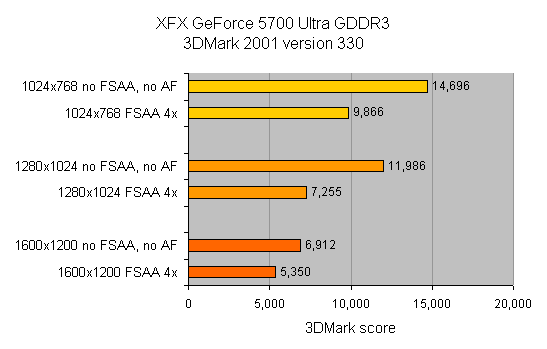
Verdict
Key Specifications
- Review Price: £140.00
It’s a cruel fact of life that the high-end component you paid top dollar for will, in an often agonisingly short period of time, be available for a depressingly small amount. And thanks to nVidia and ATi’s endless battle for supremacy, graphics cards are one of the worst culprits. It’s no surprise therefore that the mid-range is the most popular, as shelling out around £150 is more palatable than spending £400.
However, thanks to the X800 and GeForce 6800 moving into the top end, £150 will now buy you a lot of graphics card – in particular one based on the ATi Radeon 9800 Pro –a card that just a few short months ago would have set you back £300.
This being the case it’s hard to imagine why anyone would spend the same on a card based on nVidia’s GeForce 5700 Ultra chipset. While this was good value when it was first released, it would seem to be something of a hard sell right now. However, the XFX card we’re looking at here has a few tricks up its sleeve.
The first point of interest is that the card is equipped with GDDR3 memory. GDDR2 found few takers as its benefits over DDR1 were few. It only clocks to 500MHz and draws as much power as DDR1, resulting in excessive heat, which then has to be removed by overly large and noisy cooling systems. GeForceFX 5800 Ultra anyone? No, I didn’t think so… GDDR3 however, has a theoretical limit of 800MHz (1600MHz effective) yet draws less power than GDDR2. While these speeds have yet to be achieved, even this isn’t deemed fast enough and plans are underway to introduce GDDR4, reaching as high as 1.4GHz (2.8GHz effective) by the end of the year.
Returning to the present, we find that GDDR3 is employed on all the new boards from nVidia and ATi. However, some board partners have also chosen to refurbish older cards such as the 5700 Ultra, with the new memory. The GPU remains at 475MHz but the use of GDDR3 provides a speed increase to 500MHz (1GHz effective) compared to the 450MHz of the original. It’s not a huge boost but it should have some effect on performance.
However, the main issue with the 5700 Ultra was never a memory bandwidth limitation, rather the 128bit bus between the GPU and the memory that creates a performance ceiling.
Other than the GDDR3 memory, this XFX card is notable for featuring two DVI connectors, rather than the usual single DVI and D-SUB. This means, obviously, you can hook up two DVI panels directly to the card without needing a converter, enabling you to get the best quality from your dual displays. We tried it out with two 19in LCD panels and were immediately seduced by not only the large amount of high resolution desktop real estate but by the sharpness of the images.
There is a VIVO version of the card available, but this isn’t it, with just a standard S-Video out on the back plate. The gaming bundle is far from exciting, with titles such as Commandos 3, Black Hawk Down and Moto GP, failing to get the pulse racing.
So onto performance. Our first point of comparison would be with the MSi 5700 Ultra card that we reviewed back in January that used GDDR2. The problem however is that the MSi card was tested on a 2.6GHz Pentium 4, so results can’t be directly compared to our current 3.2GHz Prescott and 3.4GHz Extreme Edition test systems.
The next best comparison would be with a card based on an ATi Radeon 9800 Pro, as these are now available at around the same price. However the last 9800 Pro board we reviewed was also tested on a 2.6GHz Intel Pentium 4 machine. However, it’s still worth picking out some key results.
Even on a 2.6GHz processor a Connect3D Radeon 9800 Pro reached 68.2 FPS in Unreal Tournament 2003 at a resolution of 1,600 x 1,200, while even with a 3.2GHz system under it the XFX could only manage 34.4 –virtually half the score. The Serious Sam 2 test uses OpenGL, which would tend to favour nVidia with its stronger driver support for that API. However, even here the Radeon 9800 Pro backed by a slower CPU, is faster than the XFX GeForce 5700 Ultra GDDR3. At a resolution of 1,280 x 1,024 with 4x FSAA the Radeon 9800 Pro reaches 58fps while the XFX 5700 Ultra can only manage 47.7fps.
The ultimate test right now for a graphics card is how it fares with Far Cry. A game that eats up whatever graphics and CPU combination you feed it. We put the XFX GeForceFX 5700 Ultra to work on this at a bog standard resolution of 1024 x 768 with no FSAA or AF. Bearing in mind that we run this test with Far Cry options all set to maximum, the XFX could only pull in 32.98fps – barely a pass mark.
Clearly, the 128bit memory interface is still a bottleneck, meaning that for the price a 5700 Ultra card –GDDR3 or not, is just an OK performer. And while nVidia is concentrating on regaining the high-end performance crown from ATi it’s neglecting the important £150 mark. If you’re looking to spend that kind of money, an ATi Radeon 9800 Pro is the only sensible way to go.
However, lets not forget dual DVI. This is the only real selling point for the card and if you want this admittedly great feature, without spending top dollar for the high-end GeForce 6800 Ultra, then this XFX is worth a look – as long as you’re willing to put up with poor value 3D performance.
”’Verdict”’
With much faster cards available for less money the GeForce FX 5700 Ultra is already past it at this price – the use of GDDR3 does nothing to disguise its failings, leaving dual DVI as its only saving grace. XFX did very well getting the first retail GeForce 6800 Ultra product onto the market, but with this card it’s flogging a dead horse.
The XFX GeForceFX 5700 Ultra was tested using an Intel Pentium 4 3.2GHz Prescott CPU, 512MB of PC3200 DDR memory and an 80GB SATA Maxtor hard disk.

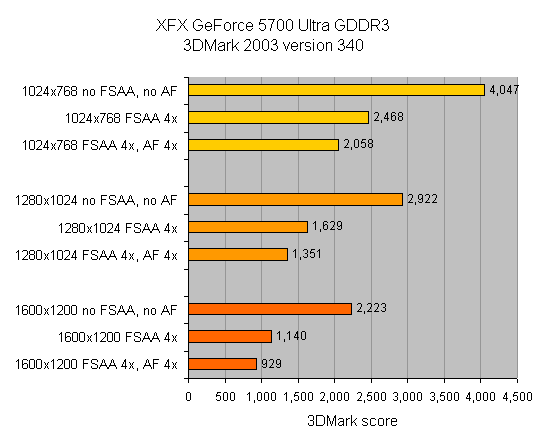
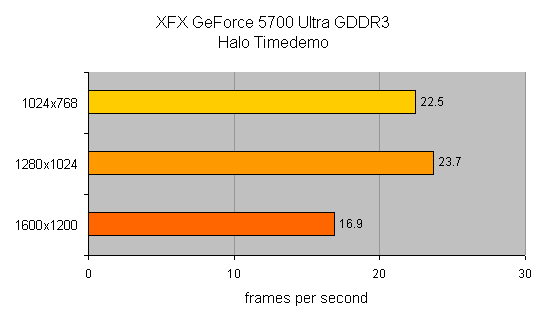
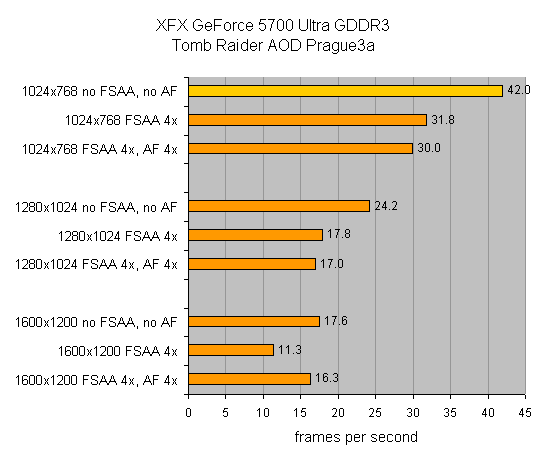
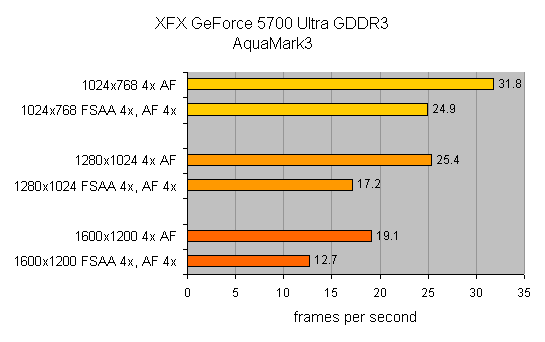
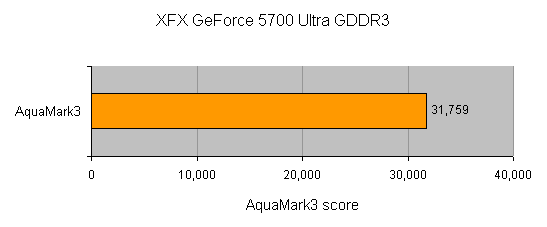
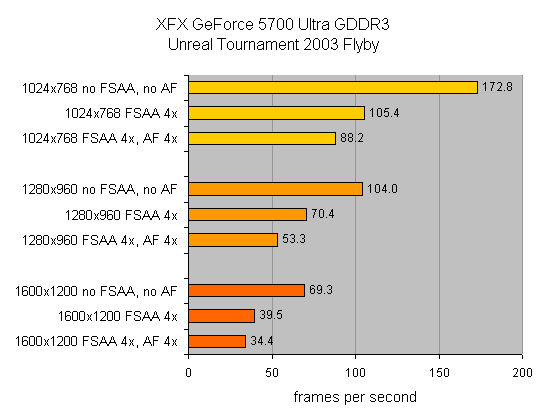
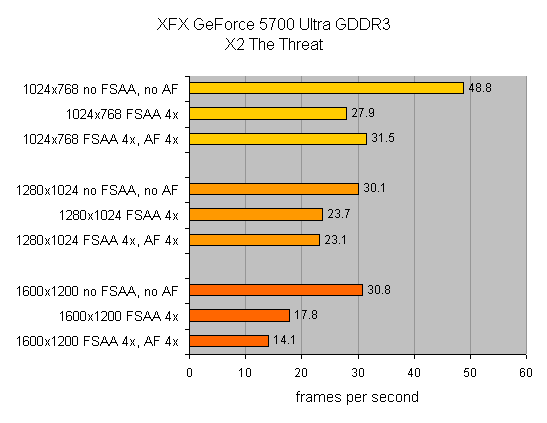
Trusted Score
Score in detail
-
Value 7
-
Features 7
-
Performance 4

